The Importance of the Dental Exam- Straight from the Horse’s Mouth
Why does my horse need regular dental exams, and what should I expect?
Continue readingWhy does my horse need regular dental exams, and what should I expect?
Continue readingJoint support is crucial for the longevity of our equine companions. Whether your horse is an elite athlete or pasture pet, joint breakdown can and will happen. What can you do about it? Are joint injections the best option? Are supplements efficacious? Read on to find out.
Continue readingIs your horse as cold as you are in that frigid winter weather? Probably not, but in certain circumstances, blanketing is necessary. Find out when your horse needs a blanket, and what sort of blanket to use.
Continue readingBiosecurity is anything that we do to protect a population (in this case, horses) against harmful biological substances. In the horse world, these are preventative measures we take to limit and minimize the spread of disease. What is your biosecurity plan?
Continue readingBy Dr. Allison Hartman
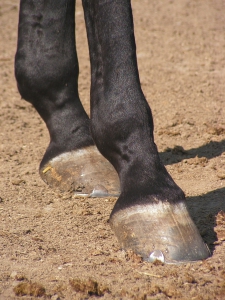 Laminitis has been a bane of horseman and farriers since the horse was first domesticated. As our medical knowledge and diagnostic abilities have evolved, so has our understanding of the contributing factors of this disease process, including Equine Metabolic Syndrome. Equine Metabolic Syndrome is a term that’s been thrown around the equine community for the past few decades, but what does it mean?
Laminitis has been a bane of horseman and farriers since the horse was first domesticated. As our medical knowledge and diagnostic abilities have evolved, so has our understanding of the contributing factors of this disease process, including Equine Metabolic Syndrome. Equine Metabolic Syndrome is a term that’s been thrown around the equine community for the past few decades, but what does it mean?
What is EMS?
Equine metabolic syndrome (EMS) is a condition most commonly characterized by an inability to properly metabolize carbohydrates. The disease has been known by many names, including hypothyroidism, peripheral Cushing disease and pre-laminitic syndrome. Today, we know that Equine Metabolic Syndrome is characterized in horses, ponies and donkeys by obesity, regional deposition of fat, and systemic insulin resistance.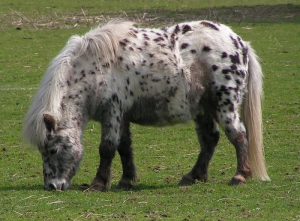
Insulin is an important hormone that allows the cells to obtain glucose from food. Without insulin, or a proper response to insulin, cells cannot utilize glucose, regardless of how much food the horse is fed. This starvation process at the cellular level pushes the horse into a stressed state (characterized by elevated cortisol levels) where the body is encouraged to hold on to as much fat as possible, making weight loss next to impossible in these horses. In addition, glucose deprivation in the laminae of the horse’s feet can lead to laminitis.
How is it Diagnosed?
When we suspect a horse may have EMS, we will recommend bloodwork to confirm our suspicions as well as guide us in the proper treatment of your horse. Horses with EMS may also have concurrent Cushing disease, which has been shown to be a contributing factor to the initial development of EMS. It is important for us to understand the underlying metabolic factors that are contributing to your horse’s case in order to provide the most efficacious recommendations both medically and diet.
The key values we assess when running blood work for EMS include:
What Can You Do About It?
Horses that are merely overweight but not actively laminitic should be put on a low starch diet, comprised of hay with less than 12% non-structural carbohydrates fed at 1-1.5% body weight. (in this example, a 1000lb horse should be fed 10-15lbs of hay per day). Their forage diet can be adequately balanced using either a ration balancer or a specifically formulated low starch feed. These horses also benefit from routine exercise as an additional aid for weight loss.
In those patients that are actively laminitic, exercise is not recommended but the same dietary recommendations apply. In addition, if your horse is diagnosed as insulin resistant (IR), metformin is a beneficial medication used to increase tissue sensitivity to insulin. Horses with IR are comparable to humans with type 2 diabetes, in that they produce adequate amounts of insulin, but their body simply fails to respond appropriately. Metformin is a medication commonly used in humans with IR and its efficacy in equine IR cases has been confirmed both in laboratory and field studies.
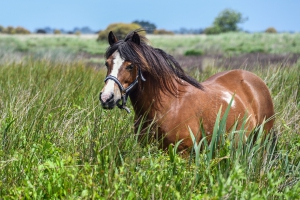 Another option to stimulate weight loss in EMS horses is levothyroxine, commonly sold in the equine community as Thyro-L. Thyro-L functions by increasing the rate of the horse’s metabolism to further stimulate weight loss. It is important to understand that Thyro-L has no direct impact on the laminae of an actively laminitic horse and instead works indirectly over a longer period of time.
Another option to stimulate weight loss in EMS horses is levothyroxine, commonly sold in the equine community as Thyro-L. Thyro-L functions by increasing the rate of the horse’s metabolism to further stimulate weight loss. It is important to understand that Thyro-L has no direct impact on the laminae of an actively laminitic horse and instead works indirectly over a longer period of time.
EMS is a frustrating disease for practitioners, clients and patients alike. The more we understand of the disease process the better our chances at restoring metabolic equilibrium and preventing further deterioration of the laminae. If you suspect your horse may have EMS, talk to your vet about appropriate diagnostic measures.
Gastric Ulcers can cause various problems with our horses’ health. What causes them, and how can you tell if your horse has them? Find out more in our December blog post.
Continue readingWith MVS now offering chiropractic services, you may be wondering what’s involved and how it can help your horse. Read on for an introduction to the basics of equine chiropractic care.
Continue readingThis is Part 3, and the conclusion of our Colic Series. If you missed Part 1, you can read it here for a basic overview of equine GI anatomy, the difference between medical and surgical colic, and some colic causes.
For what to expect financially from a colic episode, how to plan, and some of the more common causes of colic we see here in Colorado, click here for Part 2.
Today, we’ll be talking about what you can do as horse owners to help prevent colic.
In part 2 of the colic series, we covered the “common” causes of colic on the Front Range, particularly here at Mobile Veterinary Services. Unfortunately, there is no ‘magic’ formula to keep colic out of your barn, but there are a few precautions that can certainly reduce your risk.
Consistency
The first and most important rule is to understand that horses thrive on consistency. Keeping their routine as routine as you can is imperative -from feeding amounts and times to their turnout and exercise program. If you do have something that is changing (a new load of hay for example), monitor them closely and try to make that change over several days.
Weather can be a trigger as well -with winter firmly settled in here in Colorado, our weather fluctuations are constant and unrelenting. It’s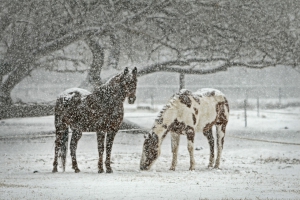 common to see 5 below zero one day and 50 degrees 2 days later. These constant changes are terribly difficult on horses and their bellies! Consistency in every other aspect of their lives can help to mitigate the effects of the things, like weather, that we cannot change.
common to see 5 below zero one day and 50 degrees 2 days later. These constant changes are terribly difficult on horses and their bellies! Consistency in every other aspect of their lives can help to mitigate the effects of the things, like weather, that we cannot change.
Water is imperative to all life. Domesticated horses who live on hay have had most of the water they would naturally consume (via live grasses) removed from their diet. As a result, our horses need access to liquid water at all times, whether this means keeping the ice off in the winter so they always have access, or keeping plenty of it available in the summer. Restriction from water for even as little as 2-3 hours can drastically increase chances of colic issues.
Dietary habits and changes
Hay diets and domestication have also led to horses eating larger, more infrequent meals. Horses are designed to graze all day, and a horse on pasture or in the wild will be grazing 18-20 hours per day. This constant eating keeps the large colon full and occupied, and the GI tract working optimally.
Although domesticated horses may be “getting enough calories,” they are consuming them over a much shorter period of time, which could potentially increase colic risk as the GI tract experiences being full, then empty, then full – not a normal state of affairs for the horse.
Parasites
Parasite infestation is a known risk factor for colic so deworming is a very important part of not only good husbandry, but also good colic prevention!
Fecal egg counts can determine whether your horse is a low, medium, or high shedder, allowing you to tailor your deworming program accordingly to your horses’ needs (instead of blanket deworming which can contribute to parasites building resistance to dewormers, rendering the dewormers ineffective).
Sand
With good preventive measures, sand can be eliminated as a risk factor. The problem simply needs to be identified. In our practice area, it doesn’t necessarily mean that you have “sand” where your horses eat. We have seen horses in the mountains of Colorado living on a hillside end up with sand in their colon. Decomposed Granite (DG) can act just like sand!! Commercial preparations of psyllium hulls fed on a regular basis can squelch the issue.
Dentition
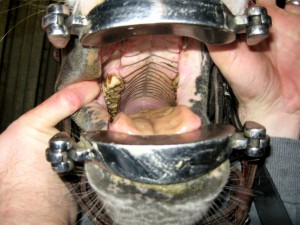
Like deworming on an appropriate schedule, regular and appropriate dental care is imperative to a good colic prevention program. If your horse can chew his food well, it can reduce his colic risk, not to mention increase feed efficiency.
Senior horses can be particularly prone to this issue, but it can affect any horse of any age. Horses under the age of 5, and seniors should have their teeth checked every 6 months. Horses in their prime with good mouths can probably go a year.
There is no way to eliminate the risk of colic in horses… unless you are on a carousel. But with good management and some preventative measures, you can significantly reduce the risk. Again, the best advice we can give is that horses thrive on consistency, and the more consistent we are in all things we do “horse,” the happier our horses are!
![]() STATE VETERINARIAN’S OFFICE (VS) – Positive Diagnosis in Two Colorado Counties Tips for Livestock Owners and Veterinarians Horses on two Montrose and one Delta County premises tested positive for the disease and have been placed under quarantine. Colorado has become the fourth state in the country to have confirmed cases of vesicular stomatitis (VS) in 2015. Previous positive cases of vesicular stomatitis this year have been diagnosed in Arizona, New Mexico and Texas.
STATE VETERINARIAN’S OFFICE (VS) – Positive Diagnosis in Two Colorado Counties Tips for Livestock Owners and Veterinarians Horses on two Montrose and one Delta County premises tested positive for the disease and have been placed under quarantine. Colorado has become the fourth state in the country to have confirmed cases of vesicular stomatitis (VS) in 2015. Previous positive cases of vesicular stomatitis this year have been diagnosed in Arizona, New Mexico and Texas.
On July 2nd, the National Veterinary Services Laboratory reported positive tests on samples submitted from horses in Montrose and Delta Counties. The initial Colorado disease investigations were accomplished by field veterinarians from the State Veterinarian’s Office at the Colorado Department of Agriculture.
“The primary spread of VS is thought to occur through insect vectors; the horses involved in these cases have no history of travel,” said State Veterinarian, Dr. Keith Roehr. “Vesicular stomatitis can be painful for animals and costly to their owners. The virus typically causes oral blisters and sores that can be painful causing difficulty in eating and drinking.”
A 2014 outbreak of VS created 556 livestock investigations in Colorado resulting in 370 quarantines with the final quarantines released in January 2015. Livestock owners who suspect an animal may have VS or any other vesicular disease should immediately contact their local veterinarian.
Livestock with clinical signs of VS are isolated until they are determined to be of no further threat for disease spread. There are no USDA approved vaccines for VS. While rare, human cases of VS can occur, usually among those who handle infected animals. VS in humans can cause flu-like symptoms and only rarely includes lesions or blisters.
New for 2015 VS Investigations: A notable change in the 2015 State response to VS has come from the US Department of Agriculture (USDA) delisting of VS as a foreign animal disease in horses; VS continues to be listed as a foreign animal disease for cattle and other livestock. This USDA procedural change will allow greater flexibility in how VS is managed in respect to equine cases. The primary change will now be that quarantines may be released as soon as 14 days after the onset of clinical signs of the last affected horse on a premises.
“Science has shown that the transmission of the virus is for a brief period of time after the initial clinical signs of VS. Our goal is to appropriately adjust our response to this disease to reduce the negative economic impact to the equine community,” continued Roehr.
With the delisting of VS as a foreign animal disease, Colorado veterinarians may now take a lead role in the management of the disease in equine cases. In earlier cases, CDA or USDA field vets were required to perform the disease investigations on horses; the delisting now allows local veterinarians to perform the initial investigations, collect samples, and collaborate with animal health officials regarding movement restrictions and quarantines. The Colorado State University Veterinary Diagnostic Laboratory has been approved to perform VS tests on horses in Colorado. This will provide a more timely response on test results.
Vesicular Stomatitis (VS) Signs and Transmission:
VS susceptible species include horses, mules, cattle, bison, sheep, goats, pigs, and camelids. The clinical signs of the disease include vesicles, erosions and sloughing of the skin on the muzzle, tongue, teats and above the hooves of susceptible livestock. Vesicles are usually only seen early in the course of the disease. The transmission of vesicular stomatitis is not completely understood but components include insect vectors, mechanical transmission, and livestock movement.
Tips for Livestock Owners:
Strict fly control is an important factor to inhibit the transmission of the disease. Avoid transferring feeding equipment, cleaning tools or health care equipment from other herds. Colorado veterinarians and livestock owners should contact the state of destination when moving livestock interstate to ensure that all import requirements are met. A list of contact information for all state veterinarians’ offices is available at: http://www.colorado.gov/aganimals. Colorado fairs, livestock exhibitions, and rodeos may institute new entry requirements based on the extent and severity of the current VS outbreak. Certificates of Veterinary Inspection issued within 2-5 days prior to an event can beneficial to reduce risks. Be sure to stay informed of any new livestock event requirements.
Important Points for Veterinarians:
Any vesicular disease of livestock is reportable to the State Veterinarian’s Office in Colorado – to report call 303-869-9130. If after-hours, call the same number to obtain the phone number of the staff veterinarian on call. With the delisting of VS as a foreign animal disease, Colorado veterinarians may now take a lead role in the management of the disease in equine cases. In earlier cases, CDA or USDA field vets were required to perform the disease investigations on horses; the delisting now allows local veterinarians to perform the initial investigations, collect samples, and collaborate with animal health officials regarding movement restrictions and quarantines. In livestock other than equine VS is still considered a foreign animal disease, any case with clinical signs consistent with VS will warrant an investigation by a state or federal foreign animal disease diagnostician (FADD). When VS is suspected in livestock other than equine the FADD will gather the epidemiological information, take the necessary blood samples, collect the necessary fluid or tissue from the lesions, and inform the owners and the referring veterinarian as to necessary bio-security and movement restrictions.
During the event, important VS disease prevention procedures include minimizing the sharing of water and feed/equipment, applying insect repellent daily (especially to the animal’s ears), and closely observing animals for signs of vesicular stomatitis.
For additional information, contact the Colorado State Veterinarian’s Office at 303-869-9130 or to view the current location of cases and other important updates and information you can visit: http://www.aphis.usda.gov/wps/portal/aphis/ourfocus/animalhealth?1dmy&urile=wcm%3apath%3a%2Faphis_content_library%2Fsa_our_focus%2Fsa_animal_health%2Fsa_animal_disease_information%2Fsa_equine_health%2Fsa_vesicular_stomatitis%2Fct_vesicular_stomatitis.
Catching joint changes early can be crucial to extending the career of your equine athlete. Read on for more information on maintaining the joints of your performance horse.
Continue reading